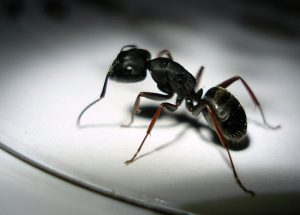The crazy ant (Nylanderia fulva) is an invasive new species of insecticide-resistant ants with an attraction for electronics. While fire ants are troublesome enough, crazy ants really seem to have ecologist and environmental researchers worried.
The Discovery of The Crazy Ant
Veteran pest control expert and Associate Certified Entomologist Tom Rasberry of Rasberry’s Pest Professionals first noted the growing problem of the electronic device-destroying crazy ants back in 2002 while working at an industrial area is Pasadena, Texas. Scientists initially had a difficult time classifying the crazy ant due to the fact that it was strikingly similar to the Caribbean crazy ant yet with a few key differences. Without a proper name following its discovery, Texas residents along with the media dubbed it the “Rapberry crazy ant” after its discoverer Tom Rasberry.
Crazy Ant Appearance and Physical Characteristics:
- Workers are typically less than an 1/8 inch long.
- 12-segmented antenna (only noticeable under a microscope).
- Colonize under rocks, structures and of course — electronics; therefore, you won’t see crazy ants in traditional dirt beds.
- Longer legs and antenna than most other ant species.
- Red/brownish-red in color.
- Rapid and oftentimes erratic movements — hence the name crazy ant.
Where Did It Come From?
The crazy ant is native to the South American countries of Brazil and Argentina. Due to its exceptionally small size (less than 1/8-inch long), there’s a good chance that humans unknowingly transported the crazy ant from South America up to the U.S. An infestation hidden in a laptop computer, cell phone, CD player or any other device could result in millions of these destructive insects being transported into the U.S. And once they bean building colonies and mating, it’s nearly impossible to stop them.
The Crazy Ant’s Hunger For Electronics
The crazy ant’s natural attraction towards electronic devices, equipment and wiring has left a path of costly destruction in their wake. Whether it’s exterior air conditioning units, transformer boxes, cars, trucks, lawnmowers or even devices inside your home, crazy ants are naturally drawn to electronics. It’s unknown exactly why they’re attracted to electronics, but some scientists believe it’s from the magnetic field and/or heat production which attracts them.
Contrary to what some people may believe, crazy ants don’t actually eat electronic devices, but rather they build their nest inside them. So, how does this lead to the destruction of a device? When a crazy ants finds its way into a device and dies, it releases pheromones which attract others nearby. As more and more crazy ants begin to pile into the device and die, their corpses break the electrical circuit, leading to failure of the device. The diet of a crazy ant typically consists of aphids, insects and nectar-rich plants.
How To Protect Your Electronics From The Crazy Ant:
- Don’t leave your electronic devices outside where they are vulnerable to crazy ant infestations.
- Keep your grass cut and lawn properly maintained.
- Park your vehicles inside a covered garage.
- The Environmental Protection Agency (EPA) approved the use of fipronil for treating crazy ant infestations in 7 Texas counties.
Crazy ant colonies can quickly spiral out of control if left untreated. At the first sight of just a single crazy ant, call a professional exterminator.
No tags for this post.
